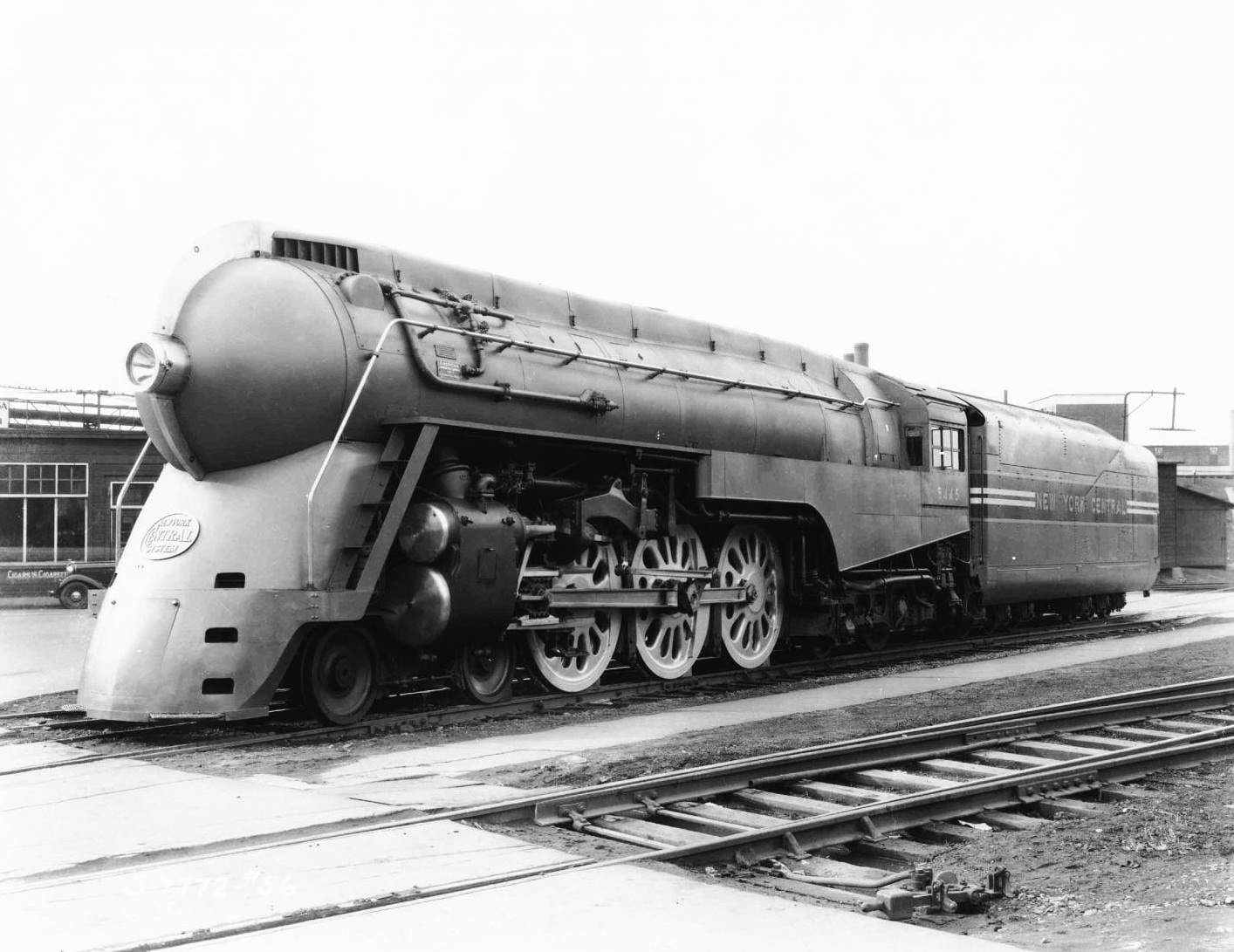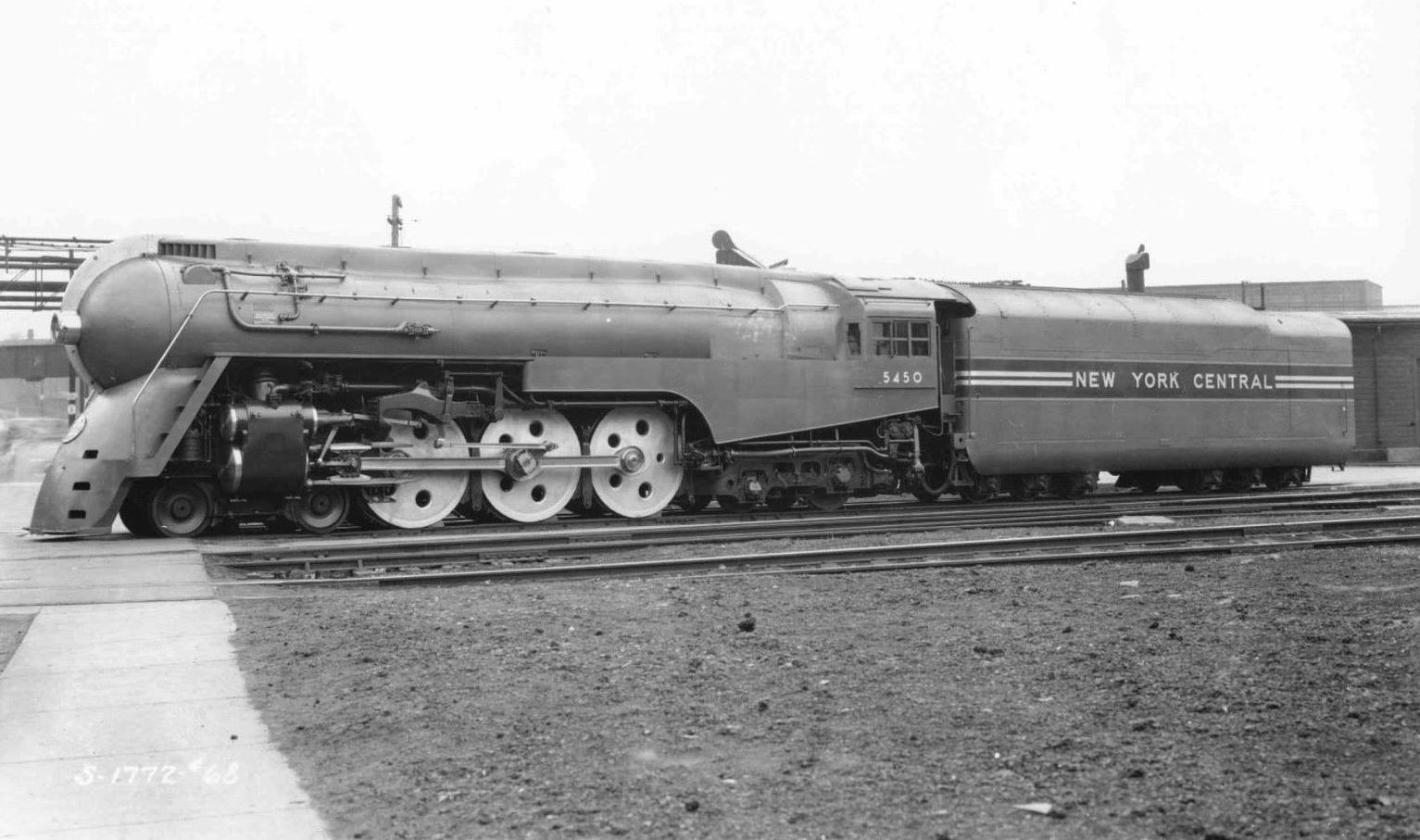NYC's 4-6-4 "Hudson" Locomotives
Published: August 1, 2025
By: Adam Burns
The New York Central was pivotal in the creation and evolution of the Hudson. These more powerful wheel arrangements were born out of a need to handle increasingly greater passenger business.
By the mid-1920s, the demand for longer trains exceeded the capabilities of the NYC's existing Pacifics, which could barely manage 12 cars. Thus, there arose a need for a locomotive robust enough to handle four to six additional cars per train.
The NYC acquired its first 4-6-4 on February 14, 1927 with the last arriving eleven years later. They were numbered consecutively from 5200, ensuring an unbroken sequence up to 5474, including those from subsidiaries. Every one of the 275 examples came equipped with boosters.
The NYC led the way in this design, owning nearly 56% of all Hudsons ever made. Many herald it as the most beautiful steam locomotive ever, yet sadly, the NYC didn’t preserve any for historical purposes.
 An American Locomotive builder's photo featuring one of New York Central's famous "Dreyfuss Hudson's," 4-6-4 #5445, circa 1938.
An American Locomotive builder's photo featuring one of New York Central's famous "Dreyfuss Hudson's," 4-6-4 #5445, circa 1938.Central's chief engineer, Paul Kiefer, found inspiration in the impressive performance of Lima's 2-8-4 Berkshire, an efficient locomotive with high horsepower. He endeavored to innovate a six-coupled passenger locomotive featuring a considerably larger firebox supported by a two-axle radial trailing truck.
Kiefer aimed for a streamlined, balanced, and visually appealing locomotive. In conjunction with Alco the duo developed the prototype 4-6-4, Class J-1a #5200 which arrived in February, 1927. In typical NYC fashion the railroad named the wheel arrangement after a body of water along its system, in this case the Hudson River.
The design primarily achieved greater power via its larger firebox grate, which was 81.5 square feet; 20% larger than a K-5 Pacific. In trials, the elegant engine achieved a 28% increase in maximum horsepower over the K-5 and delivered an additional 1,600 pounds of tractive effort.
This design proved exceptional, leading to the construction of 275 Hudsons for the NYC system and its subsidiaries. Out of these, 30 served the Michigan Central, another 30 found their way to the CCC&StL/Big Four, 20 went to the Boston & Albany, and the remaining 195 operated within the NYC. Only 10 were assembled by Lima; the majority were built by Alco.
Classes
The railroad generally utilized three different classes of Hudsons, the original J-1's, J-2's, and the final (and best remembered) J-3's. In addition, there were a handful of subclasses.
Most of the fleet consisted of J-1's, including 205 built between 1927 and 1931. Later examples in this class incorporated enhancements such as Baker valve gear, cast steel frames, and expanded tenders.
The J-2's were operated on the Boston & Albany, constructed by Alco and Lima from 1928 to 1931, which employed 75-inch drivers.
In 1935 NYC ordered fifty "Super Hudsons", the most powerful in the fleet, which arrived between 1937-1938. These featured diverse modifications to optimize performance and efficiency including higher boiler pressure (275 psi), a shorter cylinder stroke (22.5 inches), and an increased bore (29 inches).
To limit overall weight, components such as running boards and cabs were fabricated from aluminum, and lightweight alloy steel was used for mechanized parts like piston rods and main rods.
Moving away from traditional spoked wheels, the J-3's were equipped with "boxpok" and "Scullin disc" wheel designs as well as Timken roller bearings on all J-3a wheels and tenders.
The engines delivered a maximum of 4,725 horsepower at 75 miles per hour, 875 horsepower more than the J-1, achieved at a slightly higher speed.
The J-3a's resourcefulness in coal and water consumption was notable, earning it one of the leading reliability and service records of any NYC locomotive, routinely covering over 20,000 miles per month.
 An American Locomotive builder's photo featuring one of New York Central's iconic "Dreyfuss Hudson's," #5450 (J-3a), designed by Henry Dreyfuss, circa 1938. Unfortunately, this particular locomotive suffered a boiler explosion at Canastota, New York in September of 1943. She was eventually returned to service and later retired in 1955.
An American Locomotive builder's photo featuring one of New York Central's iconic "Dreyfuss Hudson's," #5450 (J-3a), designed by Henry Dreyfuss, circa 1938. Unfortunately, this particular locomotive suffered a boiler explosion at Canastota, New York in September of 1943. She was eventually returned to service and later retired in 1955.Streamlined Examples
Of the NYC's fleet, 13 were ultimately streamlined. Number 5344 is notable as the world’s first streamlined locomotive due to its shroud, added in 1934, which was styled by the Case School of Science in Cleveland, Ohio.
Initially assigned to the 20th Century Limited between Toledo and Chicago in 1935, it continued to serve until July 1939 when it was re-shrouded for a more modernized look - in part due to increased maintenance costs associated with the original "upside down bathtub" design. After a collision in October 1945, its streamlining was removed.
Data Sheet
| Class | J-2a, J-2b | J-2c | J1a to J1e | J1e 5344 (1939) | J3a | J3a-Dreyfuss |
|---|---|---|---|---|---|---|
| Railroad/Subsidiary | Boston & Albany | Boston & Albany | NYC | NYC | NYC | NYC |
| Road Numbers | 600-609/5455-5464 | 610-619/5465-5474 | 5200-5404 | 5344 | 5405-5444 | 5445-5454 |
| Builder | Alco | Lima | Alco | NYC | Alco | Alco |
| Year | 1928 | 1930 | 1927 | 1939 | 1937 | 1938 |
| Valve Gear | Baker | Baker | Baker/Walschaert | Baker | Baker | Baker |
| Driver Wheelbase | 14' | 14' | 14' | 14' | 14' | 14' |
| Engine Wheelbasre | 40' 4" | 40' 4" | 40' 4" | 40' 4" | 40' 4" | 40' 4" |
| Overall Wheelbase | 76' 1 ½" | 76' 1 ½" | 83' 7 ½" | 83' 7 ½" | 83' 7 ½" | 88' 6" |
| Weight on Drivers | 187,500 Lbs | 188,100 Lbs | 189,000 Lbs | 201,000 Lbs | 201,800 Lbs | 201,800 Lbs |
| Engine Weight | 353,000 Lbs | 357,000 Lbs | 359,800 Lbs | 370,000 Lbs | 365,500 Lbs | 365,500 Lbs |
| Tender Weight (Loaded) | 206,800 Lbs | 209,800 Lbs | 316,400 Lbs | 304,400 Lbs | 316,000 Lbs | 420,000 Lbs |
| Total Weight | 559,800 Lbs | 566,800 Lbs | 676,200 Lbs | 674,400 Lbs | 681,500 Lbs | 785,500 Lbs |
| Tender Water Capacity (Gallons) | 10,000 | 10,000 | 12,500 | 14,000 | 13,600 | 18,000 |
| Tender Fuel Capacity (Tons/Coal) | 16 | 17 | 24 | 28 | 28 | 46 |
| Minimum weight of rail | 104 Lbs | 105 Lbs | 105 Lbs | 112 Lbs | 112 Lbs | 112 Lbs |
| Driver Diameter | 75" | 75" | 79" | 79" | 79" | 79" |
| Boiler Pressure (psi) | 240 | 240 | 225/td> | 250 | 265 | 265 |
| HP Cylinders | 25" x 28" | 25" x 28" | 25" x 28" | 23 ¾" x 28" | 22 ½" x 29" | 22 ½" x 29" |
| Tractive Effort | 47,600 Lbs | 47,600 Lbs | 42,366 Lbs | 42,483 Lbs | 41,860 Lbs | 41,860 Lbs |
| Booster | 10,600 Lbs | 10,600 Lbs | 10,900 Lbs | 10,900 Lbs | 12,100 Lbs | 12,100 Lbs |
| Factor of Adhesion | 3.94 | 3.95 | 4.46 | 4.73 | 4.82 | 4.82 |
Class J-3's #5426 and #5429 received a sleek stainless steel fluted cowling to complement the Empire State Express, which was later removed in 1950. In 1938, ten J-3 Hudsons (numbers 5445 to 5454) were built with streamlining crafted by Henry Dreyfuss to match the flagship 20th Century Limited.
These ten locomotives are, without question, not only NYC's most famous locomotives but also some of the most famous streamlined engines of all time. By 1945, these shrouds too were removed and sadly no examples were ever preserved.
Recent Articles
-
Florida - Wine Tasting - Train Rides
Dec 22, 25 11:47 AM
Wine by train not only showcases the beauty of Florida's lesser-known regions but also celebrate the growing importance of local wineries and vineyards. -
Iowa Thomas The Train Rides
Dec 22, 25 10:50 AM
This article explores the magical journey of spending a day with Thomas and what families can expect from this unforgettable experience in Iowa. -
North Carolina Thomas The Train Rides
Dec 22, 25 10:45 AM
North Carolina is one of the few states home to two different Thomas the Tank Engine events. Learn more about them here!


